How To Predict the Future?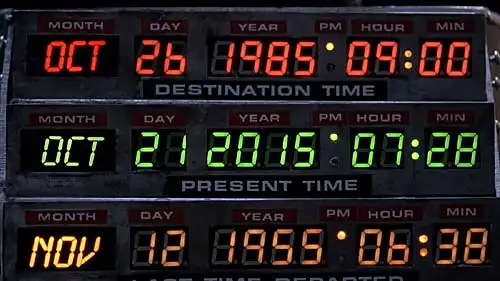 Speculations by Stefan Stenudd
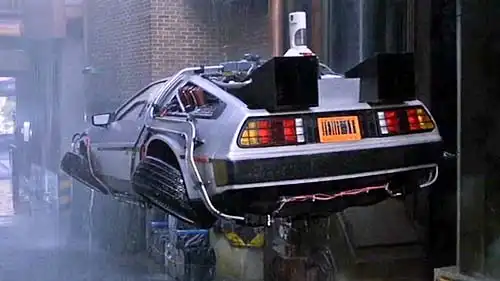 The flying DeLorean of Back to the Future II.
Dreams of FlyingOne thing that tends to dominate what we imagine about the future is flying. In Back to the Future II, flying is a big thing. The DeLorean made famous in the first movie is now airborne, and skateboards have become hoverboards.
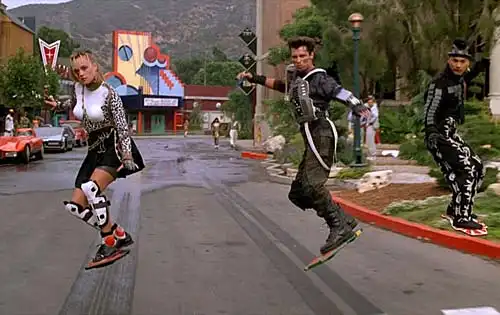 Hoverboards in Back to the Future II.
Flying cars, as the above mentioned DeLorean, can also be found in the dystopian 1982 movie Blade Runner well, in a lot of sci-fi films.
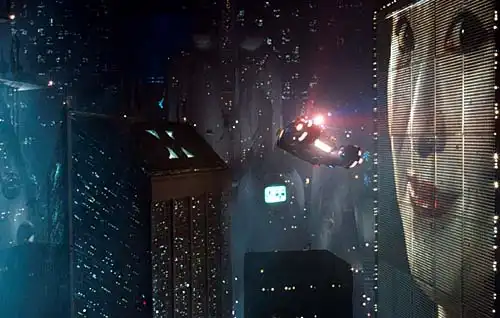 Flying car in Blade Runner.
2001 A Space Odyssey has an early scene with regular people on a space vessel, as if space travel would already at that year be commonplace. The movie premiered in 1968, one year before the first moon-landing. It was easy to imagine that soon enough everybody would go there.
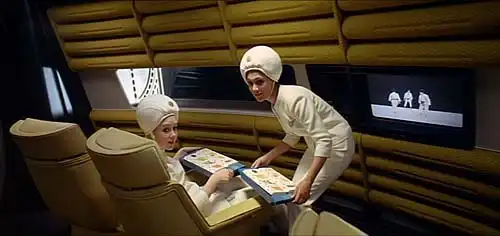 Spaceline hostess in 2001 A Space Odyssey.
Surely, we still dream about flying. But in our present zeitgeist, space is little more than that dark, cold and empty thing extending beyond our reach and way beyond our urges. From tempting us to boldly go where no man has gone before, space has become barren, even hostile, as can be seen in several recent sci-fi movies. Just because it's out there, we don't necessarily feel like going there. Our dream of flying is closer to the ground.
Robot SlavesAnother recurring theme in our images of the future is the robot, the idea of man-made creatures. In the 20th century they were often envisioned as servants slaves, actually, but without the moral issue since they were mechanical.
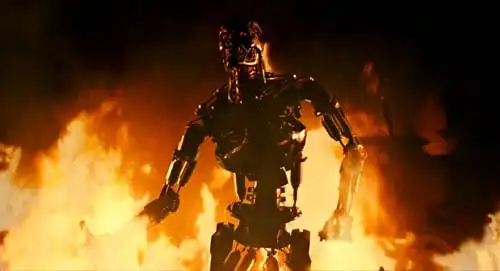 The persistent assassin robot in Terminator.
The future from which the assassin robot arrives is set to 2029, so we are not sure just yet that it will not come true... Another 1980s film with the same ingredient is RoboCop from 1987. Robots designed to take care of law and order are turned against us, though this time in evil human control.
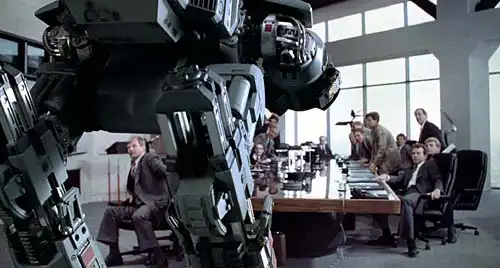 A vicious robot in RoboCop.
Sort of along the theme of the robot is the android, a human made life form in our image. Again, this creature is presented as intended to be a kind of slave without the guilt-feelings. A human-like being that is not regarded as human. A terrible concept, most definitely. The horror of it is shown in the above mentioned Blade Runner, where the misery of the androids (called replicants in the movie) is painfully evident, and their revenge understandable. The replicants are so similar to humans that only psychological tests can reveal them. Yet, they are allowed to be treated as dispensable commodities.
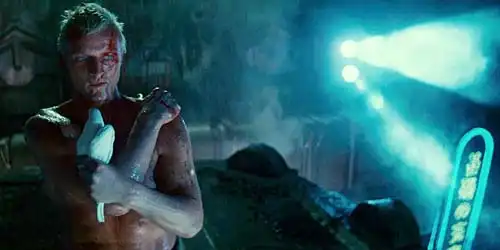 A suffering replicant in Blade Runner.
Computer ConquestA third recurring ingredient in future scenarios is the supercomputer. I would say that it started to be realistic in the 1980s, when computers became accessible to us all, and it has indeed changed society thoroughly.But it was imagined in the cinema already in 1968 with 2001 A Space Odyssey, where the spaceship computer HAL (Heuristically programmed ALgorithmic computer) gradually takes over.
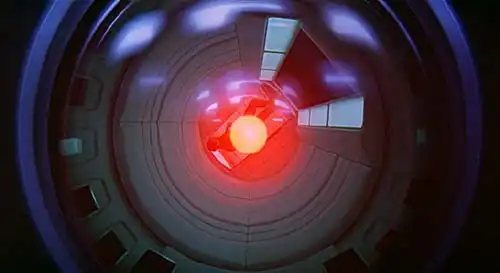 The all-seeing eye of the computer HAL in 2001 A Space Odyssey.
Contrary to robots and androids, it may have been invented as a kind of slave, but it is close to enslaving mankind. We depend on it so much, nowadays, that it sort of guides our lives. Not to mention how it scrutinizes our lives.
Some Things Change, Some Don'tThe future is definitely not easy to predict, neither in fiction nor in science. I have written a couple of science-fiction novels and wrestled with these difficulties with moderate success.In one of the novels, I thought myself clever to have a future setting being sort of a museum of that future's past. That way, I could speculate about future ingredients and still get away by them already being antiques in the more distant future. I'm not sure it was foolproof. In the other sci-fi novel I really blew it when having a newspaper far in the future work with teleprinters, which are already completely obsolete. Well, so will newspapers soon be, it seems. That novel is in English. See more about it here:
All's EndI remember being impressed by the 1978 Superman movie opening scene, where Marlon Brando as Jor-El in his lab works with what seems to be crystals. No keyboard, no metal machines, just crystals. A clever leap away from the prejudice of the present. They have been wise to use those gadgets in the sequels, too.
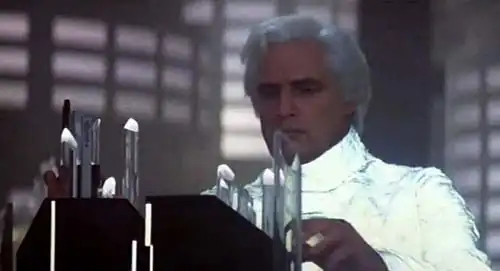 Jor-El working the crystals in Superman.
The human character, for example, seems to remain the same through time. History teaches us that. The old Greeks were not different from us, although more than two millenniums have passed. Their abilities and shortcomings remain with us, as do their urges. We are what we are, and we do what we do. Outer appearances change, as do the tools and toys we have at our disposal. But within all that, we go about our business pretty much like always.
The Future We Long ForThe persistence of the human character is probably why some things don't change that much in mere decades. We are eager for changes that are in line with our urges, and dismiss the rest.For example, space travel is fine in the cinema, but not worth the bother to do in real life since it is not likely to significantly change the situation we have at home in our everyday lives. We do dream of flying and we have vessels for that. But what we really dream about is flying of our own accord, without machinery. If that one day seems doable, we will hurry to make it come true, whatever the cost. As for computers, they started off as powerful tools and toys for the brain, which was something unique. For a long time, we have had plenty of tools for the body, making work easier and games more exciting physical experiences. But the computer was the first tool just for the brain, to help it think and do it faster than ever before. So, it had to be a success. Our brains demanded it. The personal computer was hard to imagine in the middle of the 20th century. Computers were too big and far too costly. But as soon as it became possible to make them for the regular consumer, they swarmed the planet and nothing has been the same since. Maybe the computer is the invention that has the potency of actually changing the human character, since it stimulates the very organ that forms our character and behavior.
Locked Inside the Realm of the MindThe Internet is another recent sensation. Again, it is an instrument for the brain, allowing us to search the world in seconds and satisfy our curiosity about anything we can imagine. We now have immediate access to the whole human universe, albeit in its cyber-form.Personally, I have my doubts about the progress caused by the smartphone. It is sort of a pocket computer, which is fine by me, but it also tends to be an even greater waste of time than TV, which is fortunately retreating. Are we moving from bad to worse?
 Old and new in the Tokyo subway. My own photo.
And what people do with their smartphones is rarely that interesting or ingenious. It is a tool for the brain, of course, but it seems to be making it deteriorate. Locked to their smartphones, people behave more and more like zombies. No wonder such films have gotten so popular these days. As it seems today, our future is one where we are not conquered by computers, but isolate ourselves inside them, like a fetus in the womb. We might not be turning into undead zombies, but are we regressing to the state of the unborn? Maybe what we want of the future is to let go completely of our bodily existence, and be but the figments of our minds. That's not so far from religious ideas of the spirit's life in the ever after. In other words, is that which we ultimately long for simply death?
Stefan Stenudd October 21, 2015
More Speculations
About CookiesMy Other WebsitesCREATION MYTHSMyths in general and myths of creation in particular.
TAOISMThe wisdom of Taoism and the Tao Te Ching, its ancient source.
LIFE ENERGYAn encyclopedia of life energy concepts around the world.
QI ENERGY EXERCISESQi (also spelled chi or ki) explained, with exercises to increase it.
I CHINGThe ancient Chinese system of divination and free online reading.
TAROTTarot card meanings in divination and a free online spread.
ASTROLOGYThe complete horoscope chart and how to read it.
MY AMAZON PAGE
MY YOUTUBE AIKIDO
MY YOUTUBE ART
MY FACEBOOK
MY INSTAGRAM
MY TWITTER
STENUDD PÅ SVENSKA
|
 Sunday Brunch with the World Maker
Sunday Brunch with the World Maker